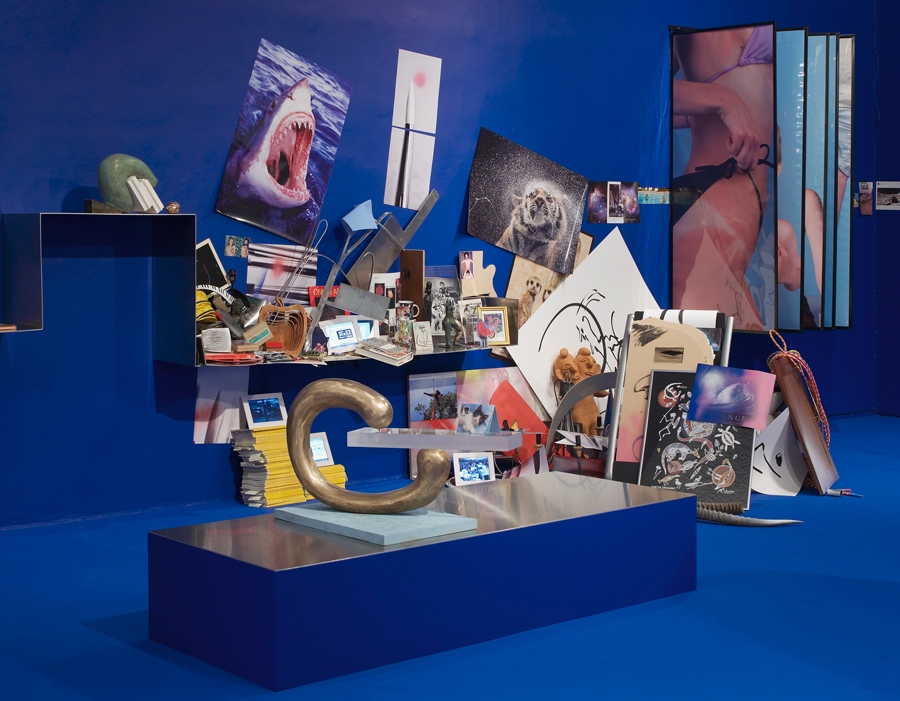French artist Camille Henrot has received much attention since she won the Silver Lion at the 2013 Venice Biennale for her film Grosse Fatigue (2013). Translated as ‘great exhaustion’, it consists of a 13-minute video in which a rap voice attempts to tell the story of the universe, combining mythical, religious, historic and scientific narratives, while a flow of images flash by simultaneously on a desktop computer.
Taking over the Chisenhale Gallery, Henrot builds on this previous work to create The Pale Fox, in which a similar narrative unfolds, but into space rather than on a computer screen, and that turns the feeling of exhaustion into a meditative and enveloping experience. The walls and carpet are coloured in a deep soothing blue reminding of Yves Klein’s monochromes, while atmospheric, ambient music plays in the background, periodically punctuated by coughing sounds. In this enclosed cosmos, Henrot presents what seems to be her very own universe, including found images, objects such as books, educational CDs, digital tablets, coloured feathers and a snow globe, some of her ink drawings and sculptures, as well as a polymorphous set of undulating aluminium shelves that run across the walls. Creating an uneven visual frieze, the images and objects cover the gallery walls, occasionally overflowing on to the floor, on which a radio-controlled snake slithers around.
Dogon mythology is central for Henrot as, built on the assimilation of different cultural belief systems, it becomes a philosophical model for the construction of her narrative
Behind this apparent chaos lies what Henrot calls a ‘crazy schematic map’ which, drawing on different systems of knowledge, apparently describes the cyclic creation of our universe. The disparate objects are there to represent both a point on the compass and one of the elements, one per wall. This spatial map also corresponds to stages in the development of human life, technological progress or mythological genesis.
The north wall for instance relates to the element water – the artist informs us in the press release – where objects and images are gathered that are associated with creation and fertility such as gourdlike calabashes, an apple, or Gabagunnu, the womb matrix of the world, as featured in Dogon mythology. Frequently referred to throughout the installation, this West-African mythology is central for Henrot as, built on the assimilation of different cultural belief systems, it becomes a philosophical model for the construction of her narrative.
Further on, there is the unfolding and evolution of human life, bringing about technological progress, as symbolised by the tablets and the accumulation of photographic images, and which leads to photographs of sunburnt bodies, a metaphor for man’s overexposure. Elsewhere a newspaper cutting, on the archaeological discovery of a Greek statue, hangs next to biblical crosswords, while a Silver Surfer Marvel comic is placed alongside an image of a Buddhist ritual.
The logic is sometimes hard to follow, and the references not always easy to decode without a press release to guide us through. Although captivating and absorbing as an environmental installation, it is the different layers of meaning and symbolic references interwoven together that make this complex work interesting, even when those references are cryptic and reliant on the viewer having some familiarity with Griaule and Dieterlen’s anthropological study of Dogon mythology, Leibniz’s philosophy or Henrot’s Grosse Fatigue.
That being said, once you have read the artist’s statement, Henrot does manage to make these overlapping narratives work together in one great cycle, without them seeming contradictory. She reminds us that disorder and entropy are the origin and condition of creation and evolution, just like the ambivalent figure of the Pale Fox in Dogon mythology is both destructive and creative. In a world where we are constantly overwhelmed by images and information, Henrot’s installation is an impressive attempt to make this excess and chaos productive again.
7 April 2014
